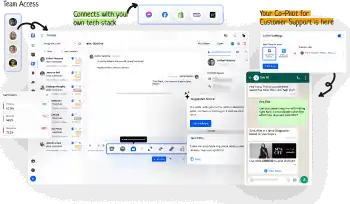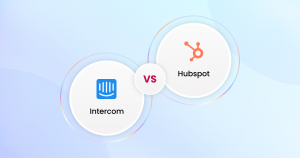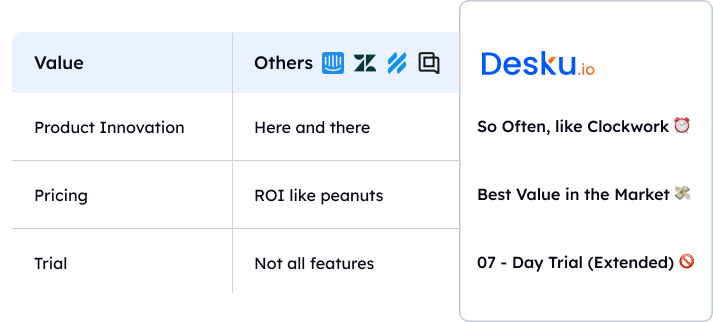Seventy percent of the corporate officers in this Zendesk Customer Experience Trends Report 2023 say that they expect agents to enlarge their functions. The more support you offer, the greater the requirement for scalability and a tool or platform that expands alongside your support staff.
Zendesk has been developed as a complete package for customer service and provides embedded best practices that enable you to maintain a distinct CX at scale. Additionally, Zendesk’s focus centers highly like a few of its top competitors, on the CX; hence, we can comprehend those facilities that make serving customers easier as they improve on agent experience.
But what about Front? Is it cool enough to be an alternative option? Is it similar in that respect to Zendesk? Also, is it cheaper than Zendesk?
Now, it is time we compare Zendesk and Front to discover the best among them.

Key Takeaway :
Front and Zendesk are both powerful customer communication platforms with unique strengths and weaknesses. Front is a team inbox product that simplifies communication and enhances collaborative work, making it a cost-effective option for small and large organizations. On the other hand, Zendesk is a comprehensive customer service system with a focus on enhancing customer interaction and satisfaction. The choice between Front and Zendesk depends on the specific needs and priorities of your business, as each platform offers distinct features and benefits.
Zendesk

Zendesk belongs to a customer service firm with its main offices located in San Francisco, CA – USA. The company’s main product is an integrated SaaS system featuring comprehensive instruments for enhancing customer interaction, increasing overall customer satisfaction, and simplifying client service operations.
Zendesk’s products include support tickets, call center solutions, knowledge base management, online chat, customer segmentation, and analytics. This is how Zendesk assists organizations in improving customer experience, which leads to increased customer loyalty by centralizing and making these customer interactions easy to manage. Besides Front, some of it’s closest competitors are Intercom, ServiceNow, and Front, while Desku stands tall as a better alternative.
Front
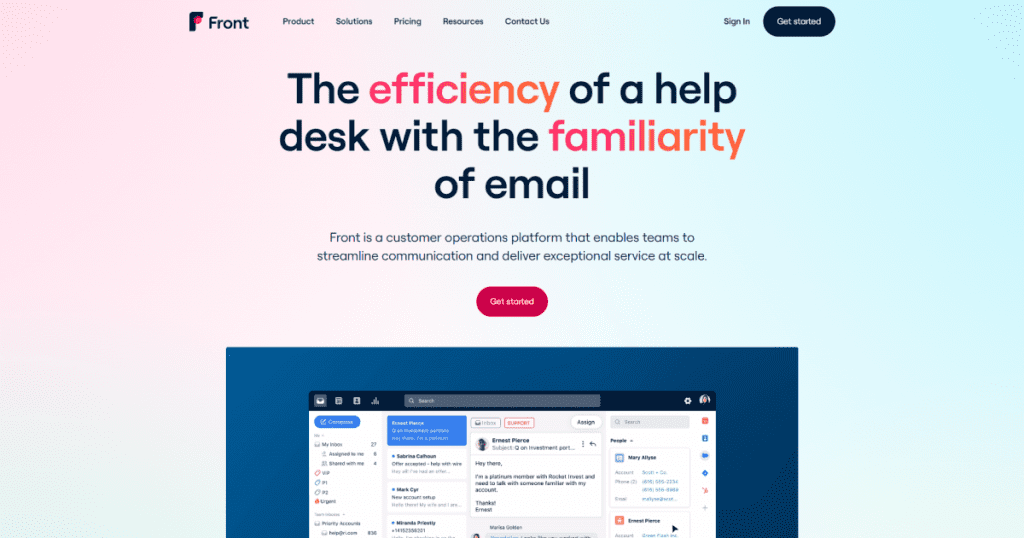
Front is an American company located in San Francisco, CA, USA, and it develops a team inbox product. It includes the simplicity of email with automatic feedback and insights. Teams from a single place manage users’ communication.
Teams can use Front to engage in joint effort control workflow as well to see what happens at the external communication level. Email, SMS, Social networking sites, live chats, phone calls, as well as software third-party integrations are some of its main characteristics. Front aims to enhance collaborative work within a team and ensure each member is treated individually, pretty much like Jira.
Kayako seeems to be the closest competitor of Front as of now, and this software even beats Zendesk on a few grounds. Check this awesome comparison guide for in-depth information.
Front vs Zendesk: Desku as an Alternative
In contrast to both the services discussed, Desku provides a cost-effective option without skimping on capability. Although this may not be easy for small organizations, this is where Desku provides competitive pricing models, ensuring accessibility while meeting all necessary features. Desku is also affordable, making it ideal for organizations that would like to get maximum utility from their customer support budgets. Customer engagement is much better with Desku.
In relation to Front, Desku is easily used and has an efficient automation system. In terms of automation, Desku’s pretty awesome. Starting from assigning chats to escalating inquiries makes support flow processes effortlessly; everything is handled.
Multi-chat messaging enables support teams to answer queries from different sources within a single interface, improving operations efficiencies. Desku integrates with Salesforce and Hubspot in addition to many others, making it possible for organizations to have one system of managing customer information across all departments.
Additionally, organizations now have the option to receive customized analytics reports that are based on these customer support interactions and are able to draw meaningful actions out of them.
Desku’s collaborative functionality allows jointly working on emails with colleagues, implementing easy-to-track tags & filter sorting, as well as a quick response support service for prospective users.
Desku presents itself as a robust alternative to Zendek(check shocking negatives) and Front and many other similar software. It provides a generous 14-day free trial) and more integrations than most of the competitors.
Desku’s dedication to rendering a holistic, affordable, and audience-focused system makes it a worthy option for companies searching for another tool that prioritizes efficiency while cutting costs under management systems for customer service solutions.So, if you want a help desk software better than Zendesk suite, Front, and Freshdesk, something that offers great value for money and leads to customer success, something that support agents truly love, go for Desku. You can know more about Desku’s tremendous features by checking the reasonably priced plans.
Similarities Between Zendesk and Front
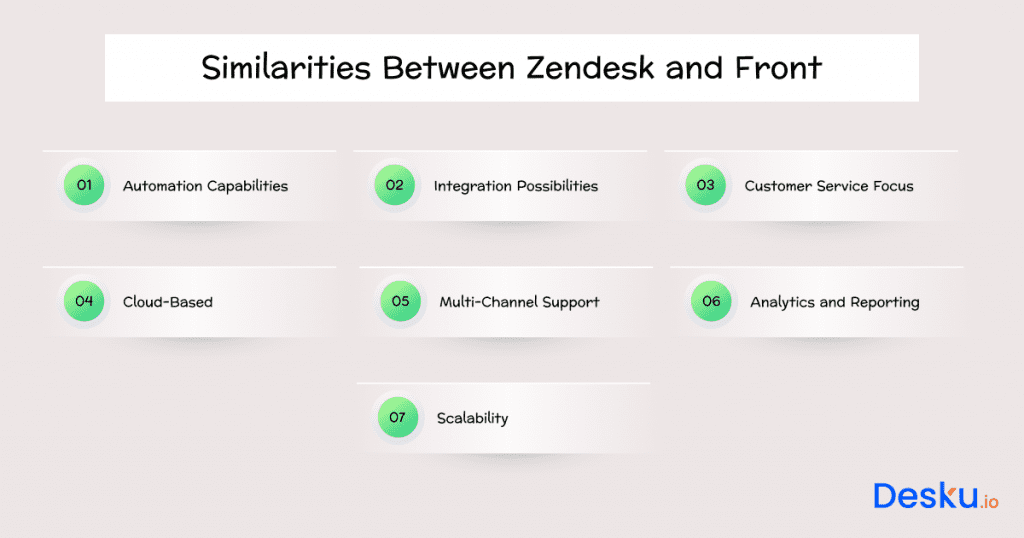
- Automation Capabilities: They both provide automation functions that allow businesses to automate recurring duties, optimize processes, and enhance productivity of the customer facing teams.
- Integration Possibilities: Each of them supports integration with a large number of external applications. Businesses are also able to consolidate their tools and processes into a single platform, thereby facilitating higher productivity and efficiency.
- Customer Service Focus: Customer service is always at the core of designing both Zendesk and Front. Both platforms have features that can be utilized by businesses in order to ease interaction with customers.
- Cloud-Based: In essence, Front and Zendesk mainly run on clouds, leading to higher levels of mobility (remote) and easy update provision with minimal requirements on external interruptions.
- Multi-Channel Support: They both provide a communication experience for multiple channels via email, social networks, live chat as well as telephone. Such multi-channel support makes it possible for different types of businesses to access even distant customers.
- Analytics and Reporting: The analytical and reporting abilities of both platforms allow companies to comprehend performance indicators as well as communicate with clients in a more organized manner depending on existing statistics from available data.
- Scalability: Zendesk and Front will also scale as any business grows. Various plans and customization options cater to the needs of businesses regardless of their size. Either support solution gets good score for this.
Key differences between Zendesk and Front

- Purpose of Design: As a customer service tool, it focuses on the management of customer interactions with the aim of efficient resolution of queries from customers. However, a core competency for Front is its status as a team communication application, with all manners of messages being pooled into a unified inbox.”
- Pricing: There are, however, differences in their pricing models as well. Zendesk’s pricing normally works out on a per agent per month basis and depends upon the features needed in the package chosen by the customer. Nevertheless, it provides a pay-as-you-go pricing structure and offers various price packages depending on the needed functionalities.
- User Interface: The company has developed an innovative, user-friendly user interface for its customers, which can be adjusted according to the requirements of businesses. However, Front has a less complex interface that resembles typical email clients and could be more accessible to email-centric organizations. Account management is also a bit tough
- Integration Capabilities: Although both systems include third-party app integrations, Front is widely known for having strong integration characteristics that give customers an opportunity to use several different business applications straight out of the mailbox.
- Deployment: Although Front is a cloud-hosted service, it has two types of deployment, namely cloud-based and on-premise, which offers more flexibility to large organizations with stringent requirements regarding their sensitive data.
- Collaboration Features: The collaboration capability of Front is greater than that provided by Zendesk, making it better when it comes to support customers in huge numbers. For example, a team can exchange comments on emails sent, task delegation, and tracking of email trends in a Front platform.
Zendesk vs ServiceNow: Head to Head

ITSM Solutions
Although both Front and Zendesk are moving into the realm of ITSM, they each emphasize different aspects. Front helps with collaborating internally and makes it easier for the IT team members to communicate and solve problems.
The practice of collaborative action complements ITSM principles and promotes an atmosphere that encourages effective resolution of problems. In contrast, Zendesk includes ITSM functions but is a famous player in wider areas of customer service.
As such, its ITSM features seamlessly incorporate into its greater package, making it a perfect solution for companies looking for the whole package in one.
User Interface
Helping teams need to have peace of mind to fulfil customer needs, and for that, UI is very important. It goes without saying that the experience for Front is also different from that for Zendesk support tool. The Front is a good tool that boasts of a smart, user-friendly interface where communication tops the agenda. You get a unified inbox design, which combines emails, chat, and other messaging applications into one collaborative portal.
However, Zendesk, with its simple approach, uses a more modular approach. Its dashboard enables user movements from tickets, knowledge base, and reports at ease. The two platforms emphasize simplicity, with their respective choices depending on what is preferable to an individual.
Integration Capabilities
A customer support platform that integrates easily with other tools or systems could have profound implications on operational efficiency. The capabilities for integration between Front and Zendesk vary.
The front has a wide array of native integrations, enabling customers to interact with common software such as Slack, Salesforce, and so on. These interlinkages foster teamwork, thereby creating a uniform workplace culture.
However, Zendesk has an expansive App Marketplace offering its users multiple third-party integration options. For a business seeking to align its process of providing customer services with existing workflows and other applications, depth and breadth of integration becomes paramount.
Customization and Automation
Customization and automated workflow are key considerations for choosing the platform. Moreover, Front stands out on adaptability for enabling customized operations as per users’ needs. Through customizable inboxes, automatic rules, and integrations, Front enables individuals to shape the platform based on their operations.
Triggers, automation, and macros used by Zendesk’s renowned automation capabilities ensure the smooth functioning of processes. Another significant consideration is its extended opportunities for customization via App Marketplace.
This is because there are different levels of flexibility and automation depth suited for particular workflows in the business organization.
Scalability and Enterprise Solutions:
In a growing business, scalability and enterprise-class solutions are crucial. The company positions Front as a platform that is ideal for small and large firms whose requirements are likely to change.
This is mostly due to its easy interface and collaborative elements suitable for small to medium companies. In contrast, ZenDesk’s multiple solutions package and great flexibility are ideal for business growth.
It is meant for large companies that have more sophisticated maintenance/support needs. Businesses intending to scale up or venture into enterprising must understand the scalability and the enterprise-centered functionality of every platform.
Customer Support and Service Level Agreements (SLAs):
Any customer support platform must be able to properly handle inquiries and meet SLAs. It highlights real-time collaborations for technical support teams with the purpose of offering quick solutions to customers’ problems.
The shared inbox and collaborative nature of it give it a holistic approach to addressing customers’ needs. However, Zendesk is the best for support workflows involving ticket systems as well as SLA enforcement through automation.
Zendesk has strong reporting and analytics tools that allow a business to keep track of its support performance. This comparative analysis of Front and Zendesk, as regards customer support capabilities, highlights their unique abilities towards prompt and effective responses to customer queries.
Zendesk Suite vs Front: Price
Lastly, the juicy bit of the matter is the price issues. The plans offered by Front App include a starter for $9 users per month, plus $24 users per month, pro for $39 users per month, and enterprise at $79 users per month, respectively.
Remember that this is per annum pricing, but you will pay slightly extra if you opt for a monthly charge. You will need to pay for the Pro plan to unlock all these features mentioned, plus Unlimited advanced rules for faster responses, CRM integrations, data exportation, and in-app billing management.
There are about five pricing models for Zendesk. These include essential ($5 per agent/month), team ($19 per agent/month), professional ($49 per agent/month), enterprise ($99 per agent/month), and elite ($199 per agent/month) plans.
In other words, customers rarely consider the cheapest option as it can hardly be any simpler than that. With the Professional plan, you are able to experience Zendesk Phone Support (English speaking only), various communication channels of customers, predefined responses (Macros), Add-on tools for collaboration (Light Agent and side conversations), conditional ticket fields and CSAT along with follow up surveys.
FrontApp pros & cons
Pros:
- It’s an ideal option for a team running on a common inbox.
- They monitor email response time without focusing on such.
- Governed as per GDPR standards, SOC 2, and others.
- Accommodates a five-user team to as large as a thousand.
- Trends in customer communication and distribution of duties are identified through analytics.
- Enables automatic, custom-design workflows that allow team members to concentrate their efforts, ensuring customers continue being satisfied.
- Aims to facilitate real-time collaboration to cut off bottlenecks.
- Provides open APIs for future customization.
- Secure with industry-standard encryption
- Integration with 100+ apps
Cons:
- When scaling up for a larger team, this may prove rather costly.
- In some organizations, this large migration necessitates training of people on a new platform.
- It is not perfectly designed for sales teams.
- Designed to replace your inbox.
- Lacks integration with some apps
- All email communications are moved to one platform.
- Provide cloud-based only solutions, which can be considered as a minus for bigger corporations requiring on-site solutions.
Pros & Cons of Zendesk
Pros:
- The platform enables powerful customization
- Offers solutions for sales teams
- Completely detailed list of features and functionality.
- Offers solutions for support teams
- Excellent collaboration tools
- SOC 2 compliances plus governing regulations such as GDPR.
- Tracks’ service covers web, mobile apps, and social networks.
- Excellent security functionality and support
- Powerful ticketing system software
- Extensive knowledge management platform
- Live chat software
- Forum Software
- Provides personalized customer services, allowing companies to stay productive.
- Over 1200 integrated apps in its extensive app marketplace.
Cons:
- However, some communication is bound by default to a round ticketing system.
- People need education and development in order to use it at maximum.
- It forces you to take a leap of faith into their system.
- The ticketing system is not ideal in all cases since some businesses don’t like handling customer issues through email.
- It is costly if you tend to utilize every feature available.
- Offer cloud-based solutions, which could, however, be considered a disadvantage for some bigger organizations that need on-premise answers.
- Technical setup required
When to use Zendesk

- Knowledge Base Requirement: Zendesk’s knowledge base feature could really add value to companies setting out to build an all-encompassing customer self-service portal.
- Need for Advanced Reporting: Zendesk provides more advanced tools if your company makes its decisions based on data and requires sophisticated analytics and reporting.
- Strong Customer Service Focus: If your business prioritizes customer services and the specific solution targeted at the management of customer interaction, Zendesk is a cool choice.
- Multilingual Support: The multi-linguistic support offered by Zendesk helps business firms located in different areas interact with a diverse clientele.
- Customization Requirement: Zendesk has more flexible options because if your business needs a personalized user interface and workflows tailored to specific operation requirements, you should consider their services.
When to use Front

- Specific Deployment Needs: Businesses with specific regulatory or data security requirements find Front’s option for both on-premises and cloud-based deployment more fitting.
- Collaboration Needs: Shared inbox functionality, in-house comments, and task delegation are all available on Front, and they serve as great tools to enhance collaboration in teams and increase the efficiency of business processes.
- Email-Centric Teams: Front’s simple user interface that mimics traditional email clients may be preferable for teams that depend on emails as the primary mode of communication.
- Cost-Effectiveness for Larger Teams: As an alternative for Front’s per-user per-month pricing model compared to Zendesk’s per-agent per-month pricing, it becomes more affordable for those who operate large teams.
- Integration Necessity: The ability of Front to integrate strongly with different third-party apps and software would make this service very useful if you plan to have direct access to various business tools from within your inbox.
Conclusion
Zendesk and Front are comprehensive systems that are intended to boost customer performance in a given business. The choice between Zendesk and Front should not be construed as selecting an optimal tool since it depends on how the organization will benefit from the particular product in question.
When you have detailed knowledge regarding your opponents’ strengths, weaknesses, similarities, and differences, you will be in a position to ensure an informed action. However, in the end, the best choice will be that which answers the specific needs of your business.
You can also consider using Zendesk or Front, which provide platforms specially designed to help improve your customer service. The battle between Front and Zendesk is simply about finding a suitable package for your business, preference, and future aims.
This will enable you to settle on a proper choice that ensures the responsiveness of your employees and the quality of customers’ services as well as efficiency.
Nevertheless, at last, it can be concluded that the most appropriate option needs to be chosen which is beneficial to your organization. For example, Desku can be the best pick if your business needs efficient helpdesk with decent features.








